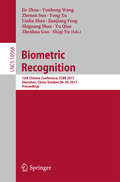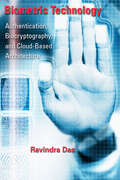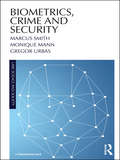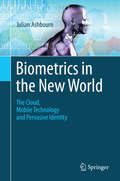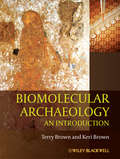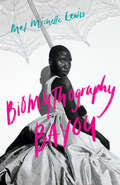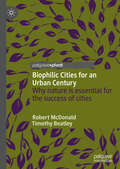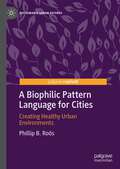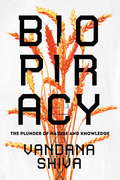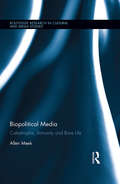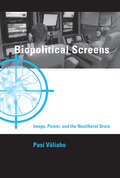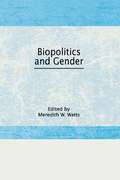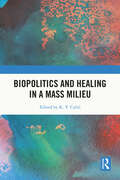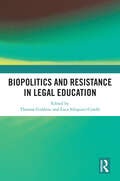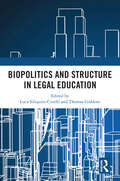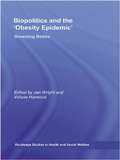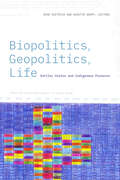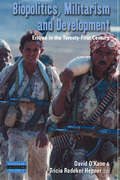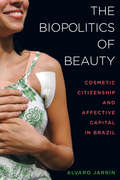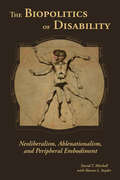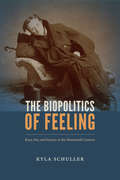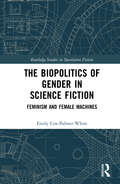- Table View
- List View
Biometric Recognition: 12th Chinese Conference, CCBR 2017, Shenzhen, China, October 28-29, 2017, Proceedings (Lecture Notes in Computer Science #10568)
by Jie Zhou Zhenhua Guo Yong Xu Shiguang Shan Yunhong Wang Zhenan Sun Jianjiang Feng Linlin Shen Yu Qiao Shiqi YuWith the increasing concerns on security breaches and transaction fraud, highly reliable and convenient personal verification and identification technologies are more and more requisite in our social activities and national services. Biometrics, used to recognize the identity of an individual, are gaining ever-growing popularity in an extensive array of governmental, military, forensic, and commercial security applications. ""Advanced Biometric Recognition Technologies: Discriminant Criterion and Fusion Applications"" focuses on two kinds of advanced biometric recognition technologies, biometric data discrimination and multi-biometrics, while systematically introducing recent research in developing effective biometric recognition technologies. Organized into three main sections, this cutting-edge book explores advanced biometric data discrimination technologies, describes tensor-based biometric data discrimination technologies, and develops the fundamental conception and categories of multi-biometrics technologies.
Biometric State
by Keith BreckenridgeGroundbreaking study of South Africa's role as a site for global experiments in biometric identification throughout the twentieth century.
Biometric Technology: Authentication, Biocryptography, and Cloud-Based Architecture
by Ravi DasMost biometric books are either extraordinarily technical for technophiles or extremely elementary for the lay person. Striking a balance, this book is geared toward the business, IT, or security manager required to make purchasing, migration, or adoption decisions. Presenting technical background on the various biometric technologies and how they work, it looks at optimal application in various settings and their respective strengths and weaknesses considering ease of use, false positives and negatives, and privacy and security issues. It also discusses exciting trends in biotechnology such as biocryptography and biometrics in the cloud.
Biometrics, Crime and Security (Law, Science and Society)
by Marcus Smith Monique Mann Gregor UrbasThis book addresses the use of biometrics – including fingerprint identification, DNA identification and facial recognition – in the criminal justice system: balancing the need to ensure society is protected from harms, such as crime and terrorism, while also preserving individual rights. It offers a comprehensive discussion of biometric identification that includes a consideration of: basic scientific principles, their historical development, the perspectives of political philosophy, critical security and surveillance studies; but especially the relevant law, policy and regulatory issues. Developments in key jurisdictions where the technology has been implemented, including the United Kingdom, United States, Europe and Australia, are examined. This includes case studies relating to the implementation of new technology, policy, legislation, court judgements, and where available, empirical evaluations of the use of biometrics in criminal justice systems. Examples from non-western areas of the world are also considered. Accessibly written, this book will be of interest to undergraduate, postgraduate and research students, academic researchers, as well as professionals in government, security, legal and private sectors.
Biometrics in the New World: The Cloud, Mobile Technology and Pervasive Identity
by Julian AshbournThis book takes a fresh look at biometrics and identity management, extending the dialogue beyond technical considerations, and exploring some of the broader societal and philosophical aspects surrounding the use of biometric applications. Features: presents a brief history of the development of biometrics, and describes some of the popularly held misconceptions surrounding the technology; investigates the challenges and possibilities of biometrics across third party infrastructures and on mobile computing devices; provides guidance on biometric systems design; explores the mechanisms necessary to enable identity intelligence, including logging mechanisms, data communications and data formats; discusses such usage issues as collaboration frameworks, and messaging and data translation; examines the impact of biometric technologies on society, covering issues of privacy and user factors; reviews the current situation in identity management, and predicts where these trends may take us in the future.
Biomolecular Archaeology: An Introduction
by T. A. Brown Keri BrownIllustrated thoroughly, Biomolecular Archaeology is the first book to clearly guide students through the study of ancient DNA: how to analyze biomolecular evidence (DNA, proteins, lipids and carbohydrates) to address important archaeological questions. The first book to address the scope and methods of this new cross-disciplinary area of research for archaeologists Offers a completely up-to-date overview of the latest research in this innovative subject Guides students who wish to become biomolecular archaeologists through the complexities of both the scientific methods and archaeological goals. Provides an essential component to undergraduate and graduate archaeological research
Biomythography Bayou (The Griot Project Book Series)
by Mel Michelle LewisWhen your stories flow from the brackish waters of the Gulf South, where the land and water merge, your narratives cannot be contained or constrained by the Eurocentric conventions of autobiography. When your story is rooted in the histories of your West African, Creek, and Creole ancestors, as well as your Black, feminist, and queer communities, you must create a biomythography that transcends linear time and extends beyond the pages of a book. Biomythography Bayou is more than just a book of memoir; it is a ritual for conjuring queer embodied knowledges and decolonial perspectives. Blending a rich gumbo of genres—from ingredients such as praise songs, folk tales, recipes, incantations, and invocations—it also includes a multimedia component, with “bayou tableau” images and audio recording links. Inspired by such writers as Audre Lorde, Zora Neale Hurston, and Octavia Butler, Mel Michelle Lewis draws from the well of her ancestors in order to chart a course toward healing Afrofutures. Showcasing the nature, folklore, dialect, foodways, music, and art of the Gulf’s coastal communities, Lewis finds poetic ways to celebrate their power and wisdom.
Biophilic Cities for an Urban Century: Why nature is essential for the success of cities
by Robert McDonald Timothy BeatleyThis book argues that, paradoxically, at their moment of triumph and fastest growth, cities need nature more than ever. Only if our urban world is full of biophilic cities will the coming urban century truly succeed. Cities are quintessentially human, the perfect forum for interaction, and we are entering what could justly be called the urban century, the fastest period of urban growth in human history. Yet a growing body of scientific literature shows that the constant interaction, the hyper-connectedness, of cities leads to an urban psychological penalty. Nature in cities can be solution to this dilemma, allowing us to have all the benefits of our urban, connected world yet also have that urban home be a place where humanity can thrive. This book presents best practices and case studies from biophilic design, showing how cities around the world are beginning to incorporate nature into their urban fabric. It will be a valuable resource for scholars and professionals working in the area of sustainable cities.
A Biophilic Pattern Language for Cities: Creating Healthy Urban Environments (Sustainable Urban Futures)
by Phillip B. RoӧsThis book presents a holistic integral sustainable design and planning method embedded in the hypothesis of biophilia, our innate connection to nature, used as a platform to chart a biophilic pattern language framework. In A Biophilic Pattern Language for Cities, the author positioned the innate human-nature connection as critical in biophilic design and sustainable city planning solutions.
The Biopic in Contemporary Film Culture (AFI Film Readers)
by Tom Brown Belén VidalThe biographical film or biopic is a staple of film production in all major film industries and yet, within film studies, its generic, aesthetic, and cultural significance has remained underexplored. The Biopic in Contemporary Film Culture fills this gap, conceptualizing the biopic with a particular eye toward the "life" of the genre internationally. New theoretical approaches combine with specially commissioned chapters on contemporary biographical film production in India, Italy, South Korea, France, Russia, Great Britain, and the US, in order to present a selective but well-rounded portrait of the biopic’s place in film culture. From Marie Antoinette to The Social Network, the pieces in this volume critically examine the place of the biopic within ongoing debates about how cinema can and should represent history and "real lives." Contributors discuss the biopic’s grounding in the conventions of the historical film, and explore the genre’s defining traits as well as its potential for innovation. The Biopic in Contemporary Film Culture expands the critical boundaries of this evolving, versatile genre.
Biopics of Women ("International Perspectives on Science, Culture and Society")
by Karen HollingerThis book is an accessible overview of biographical fiction films of women and is structured around four of the most popular subjects of female biopics: queens and political figures; entertainers; writers; and subjects of current affairs. While the biopic is commonly accepted as a deeply conservative cinematic form that represents glorification of the past and of the self-made individual, a number of biopics of women challenge all of these characterizations. They show the genre to be much more complicated and challenging to regressive ideas than has been proposed, and open to different formats and thematic possibilities. Providing an overview of key subgenres complemented by analyses of key texts that illustrate major aspects of each category, Biopics of Women examines the development of biographical films in each area and the images of successful women they project in order to investigate the issues involved in women’s representation in the genre as a whole. This is a lively and readable text for students and scholars in Gender and Film, Gender and Media, and Women’s Studies.
Biopiracy: The Plunder of Nature and Knowledge
by Vandana ShivaGenetic engineering and the cloning of organisms are "the ultimate expression of the commercialization of science and the commodification of nature.... Life itself is being colonized," according to renowned environmentalist Vandana Shiva. The resistance to this biopiracy, she argues, is the struggle to conserve both cultural and biological diversity. As the land, forests, oceans, and atmosphere have already been colonized, eroded, and polluted, corporations are now looking for new colonies to exploit and invade for further accumulation--in Shiva's view, the interior spaces of the bodies of women, plants, and animals. Featuring a new introduction by the author, this edition of Biopiracy is a learned, clear, and passionately stated objection to the ways in which Western businesses are being allowed to expropriate natural processes and traditional forms of knowledge. From the Trade Paperback edition.
Biopolitical Media: Catastrophe, Immunity and Bare Life (Routledge Research in Cultural and Media Studies)
by Allen MeekThis book presents an historical account of media and catastrophe that engages with theories of biopolitics in the work of Michel Foucault, Giorgio Agamben, Michael Hardt, Antonio Negri and others. It explains how responses to catastrophe in media and cultural criticism over the past 150 years are embedded in biological conceptions of life and death, contamination and immunity, race and species. Mediated catastrophe is often understood today in terms of collective memory and according to therapeutic or redemptive accounts of trauma. In contrast to these approaches this book emphasizes the use of media to record, archive and analyze physical appearance and movement; to capture viewer attention through shock; to monitor and control bodies in economies of production and consumption; to enmesh social relations in information networks; and situate subjects in discourses of victimhood, immunity, survival and resilience. Chapters are focused on historical case studies of early photography, Nazi propaganda, colonial stereotypes, Hiroshima, the Holocaust, the Cold War and the war on terror.
Biopolitical Screens: Image, Power, and the Neoliberal Brain (Leonardo)
by Pasi ValiahoAn investigation of the aesthetics and politics of new visual media under twenty-first-century capitalism, from console games to virtual reality to video installation art. In Biopolitical Screens, Pasi Väliaho charts and conceptualizes the imagery that composes our affective and conceptual reality under twenty-first-century capitalism. Väliaho investigates the role screen media play in the networks that today harness human minds and bodies—the ways that images animated on console game platforms, virtual reality technologies, and computer screens capture human potential by plugging it into arrangements of finance, war, and the consumption of entertainment. Drawing on current neuroscience and political and economic thought, Väliaho argues that these images work to shape the atomistic individuals who populate the neoliberal world of accumulation and war.Väliaho bases his argument on a broad notion of the image as something both visible and sayable, detectable in various screen platforms but also in scientific perception and theoretical ideas. After laying out the conceptual foundations of the book, Väliaho offers focused and detailed investigations of the current visual economy. He considers the imagery of first-person shooter video games as tools of “neuropower”; explores the design and construction of virtual reality technologies to treat post-traumatic stress disorder in veterans of Iraq and Afghanistan; and examines three instances of video installation art that have the power to disrupt the dominant regime of sensibility rather than reinforce it.
Biopolitics and Gender
by Meredith W Watts JrHere is an important book for social scientists interested in the influence of gender on certain types of behavior. Several perspectives are presented on the general topic of biopolitics and gender, including the points of view of brain science, endocrinology, ethology, psychophysiology, and such conventional interests as political attitudes, socialization, participation, social structure, and political hierarchy. The varied and provocative ideas explored in this volume will broaden discussions of gender beyond an exclusive focus on sex links to oppression and discrimination.
Biopolitics and Healing in a Mass Milieu
by K. V. CybilSeveral of the key concepts of biopolitics have come under scrutiny since the outbreak of Covid-19 pandemic. This volume brings into discussion how biopolitics can be conceptualized critically within a milieu of mass healing, such as in India. Pouring through the decolonial lens of healing, contributors to this volume discuss crucial themes like geropolitics and pandemic reflections on the question of old age; borders and logistics in a world emerging from the pandemic; immunization of humans and humanization of immunity, thus defining the Indian contexts of the biopolitical problematic. Extending its analysis into a retrospective vision of thought traditions and socio-political underpinnings that shaped modernity and post-coloniality in India, it also explores the medico-therapeutical discourse embedded in philosophy of medicine and philosophical modernity tracing its interstitial positioning as therapeutic-assemblages in a milieu of mass healing. This book will be useful for scholars and researchers of biopolitics, philosophy, political philosophy, sociology, science and technology studies, medical sociology, health and well-being, and cultural studies.
Biopolitics and Resistance in Legal Education
by Thomas Giddens and Luca Siliquini-CinelliTaking up the study of legal education in distinctly biopolitical terms, this book provides a critical and political analysis of resistance in the law school. Legal education concerns the complex pathways by which an individual becomes a lawyer, making the journey from lay-person to expert, from student to practitioner. To pose the idea of a biopolitics of legal education is not only to recognise the tensions surrounding this journey but also to recognise that legal education is a key site in which the subject engages, and is engaged by, a particular structure—and here the particular structure of the law school. This book explores the resistance to that structure, including: different ways in which law’s pedagogic structures might be incomplete, or are being fought against; the use of less conventional elements of cultural discourse to resist the abstraction of the lawyer in students’ subject formation; the centralisation of queer and feminist discourses to disrupt the hierarchies of the legal curriculum; the use of digital technologies; the place of embodiment in legal education settings; and the impacts of posthuman knowledges and contexts on legal learning. Assembling original, field-defining essays by both leading international scholars and emerging researchers, this book constitutes an indispensable resource in legal education research and scholarship that will appeal to legal academics everywhere.
Biopolitics and Structure in Legal Education
by Luca Siliquini-Cinelli and Thomas GiddensTaking up the study of legal education in distinctly biopolitical terms, this book provides a critical and political analysis of structure in the law school. Legal education concerns the complex pathways by which an individual becomes a lawyer, making the journey from lay-person to expert, from student to practitioner. To pose the idea of a biopolitics of legal education is not only to recognise the tensions surrounding this journey, but also to recognise that legal education is a key site in which the subject engages, and is engaged by, a particular structure—and here the particular structure of the law school. This book explores that structure by addressing the characteristics of the biopolitical orders engaged in legal education, including: understanding the lawyer as a commodity, unpicking the force relations in legal education, examining the ways codes of conduct in higher education impact academic freedom, as well as putting the distinctly Western structures of legal learning within a wider context. Assembling original, field-defining essays by both leading international scholars and emerging researchers, it constitutes an indispensable resource in legal education research and scholarship that will appeal to legal academics everywhere.
Biopolitics and the 'Obesity Epidemic': Governing Bodies (Routledge Studies in Health and Social Welfare)
by Jan Wright Valerie HarwoodBiopolitics and the ‘Obesity Epidemic’ is the first edited collection of critical perspectives on the 'obesity epidemic.' The volume provides a comprehensive discussion of current issues in the critical analysis of health, obesity and society, and the impact of obesity discourses on different individuals, social groups and institutions. Contributors from the UK, Canada, New Zealand and Australia provide original, accessible, and engaging chapters on issues such as the effects on individuals, families, youths and schools. The timely contributions offered by Biopolitics and the ‘Obesity Epidemic’ to this highly topical area will be of interest to a wide range of readers, including teachers, education professionals, community health and allied professionals, and academics in areas such as education, health, youth studies, social work and psychology.
Biopolitics, Geopolitics, Life: Settler States and Indigenous Presence
by René Dietrich and Kerstin KnopfThe contributors to Biopolitics, Geopolitics, Life investigate biopolitics and geopolitics as two distinct yet entangled techniques of settler-colonial states across the globe, from the Americas and Hawai‘i to Australia and Aotearoa/New Zealand. Drawing on literary and cultural studies, social sciences, political theory, visual culture, and film studies, they show how biopolitics and geopolitics produce norms of social life and land use that delegitimize and target Indigenous bodies, lives, lands, and political formations. Among other topics, the contributors explore the representations of sexual violence against Native women in literature, Indigenous critiques of the carceral state in North America, Indigenous elders’ refusal of dominant formulations of aging, the governance of Indigenous peoples in Guyana, the displacement of Guaraní in Brazil, and the 2016 rule to formally acknowledge a government-to-government relationship between the US federal government and the Native Hawaiian community. Throughout, the contributors contend that Indigenous life and practices cannot be contained and defined by the racialization and dispossession of settler colonialism, thereby pointing to the transformative potential of an Indigenous-centered decolonization. Contributors René Dietrich, Jacqueline Fear-Segal, Mishuana Goeman, Alyosha Goldstein, Sandy Grande, Michael R. Griffiths, Shona N. Jackson, Kerstin Knopf, Sabine N. Meyer, Robert Nichols, Mark Rifkin, David Uahikeaikaleiʻohu Maile
Biopolitics, Militarism, and Development: Eritrea in the Twenty-First Century (Dislocations #6)
by David O'Kane Tricia Redeker HepnerBringing together original, contemporary ethnographic research on the Northeast African state of Eritrea, this book shows how biopolitics - the state-led deployment of disciplinary technologies on individuals and population groups - is assuming particular forms in the twenty-first century. Once hailed as the “African country that works,” Eritrea’s apparently successful post-independence development has since lapsed into economic crisis and severe human rights violations. This is due not only to the border war with Ethiopia that began in 1998, but is also the result of discernible tendencies in the “high modernist” style of social mobilization for development first adopted by the Eritrean government during the liberation struggle (1961–1991) and later carried into the post-independence era. The contributions to this volume reveal and interpret the links between development and developmentalist ideologies, intensifying militarism, and the controlling and disciplining of human lives and bodies by state institutions, policies, and discourses. Also assessed are the multiple consequences of these policies for the Eritrean people and the ways in which such policies are resisted or subverted. This insightful, comparative volume places the Eritrean case in a broader global and transnational context.
The Biopolitics of Beauty: Cosmetic Citizenship and Affective Capital in Brazil
by Alvaro JarrínThe Biopolitics of Beauty examines how beauty became an aim of national health in Brazil. Using ethnographic fieldwork carried out in Brazilian hospitals, the author shows how plastic surgeons and patients navigate the public health system to transform beauty into a basic health right. The book historically traces the national concern with beauty to Brazilian eugenics, which established beauty as an index of the nation’s racial improvement. From here, Jarrín explains how plastic surgeons became the main proponents of a raciology of beauty, using it to gain the backing of the Brazilian state. Beauty can be understood as an immaterial form of value that Jarrín calls “affective capital,” which maps onto and intensifies the social hierarchies of Brazilian society. Patients experience beauty as central to national belonging and to gendered aspirations of upward mobility, and they become entangled in biopolitical rationalities that complicate their ability to consent to the risks of surgery. The Biopolitics of Beauty explores not only the biopolitical regime that made beauty a desirable national project, but also the subtle ways in which beauty is laden with affective value within everyday social practices—thus becoming the terrain upon which race, class, and gender hierarchies are reproduced and contested in Brazil.
The Biopolitics Of Disability: Neoliberalism, Ablenationalism, And Peripheral Embodiment
by David T. MitchellIn the neoliberal era, when human worth is measured by its relative utility within global consumer culture, selected disabled people have been able to gain entrance into late capitalist culture. The Biopolitics of Disability terms this phenomenon "ablenationalism" and asserts that "inclusion" becomes meaningful only if disability is recognized as providing modes of living that are alternatives to governing norms of productivity and independence. Thus, the book pushes beyond questions of impairment to explore how disability subjectivities create new forms of embodied knowledge and collective consciousness. The focus is on the emergence of new crip/queer subjectivities at work in disability arts, disability studies pedagogy, independent and mainstream disability cinema (e. g. , Midnight Cowboy), internet-based medical user groups, anti-normative novels of embodiment (e. g. , Richard Powers's The Echo-Maker) and, finally, the labor of living in "non-productive" bodies within late capitalism.
The Biopolitics of Feeling: Race, Sex, and Science in the Nineteenth Century
by Kyla SchullerIn The Biopolitics of Feeling Kyla Schuller unearths the forgotten, multiethnic sciences of impressibility—the capacity to be transformed by one's environment and experiences—to uncover how biopower developed in the United States. Schuller challenges prevalent interpretations of biopower and literary cultures to reveal how biopower emerged within the discourses and practices of sentimentalism. Through analyses of evolutionary theories, gynecological sciences, abolitionist poetry and other literary texts, feminist tracts, child welfare reforms, and black uplift movements, Schuller excavates a vast apparatus that regulated the capacity of sensory and emotional feeling in an attempt to shape the evolution of the national population. Her historical and theoretical work exposes the overlooked role of sex difference in population management and the optimization of life, illuminating how models of binary sex function as one of the key mechanisms of racializing power. Schuller thereby overturns long-accepted frameworks of the nature of race and sex difference, offers key corrective insights to modern debates surrounding the equation of racism with determinism and the liberatory potential of ideas about the plasticity of the body, and reframes contemporary notions of sentiment, affect, sexuality, evolution, and heredity.
The Biopolitics of Gender in Science Fiction: Feminism and Female Machines (Routledge Studies in Speculative Fiction)
by Emily Cox-Palmer-WhiteQuestioning essentialist forms of feminist discourse, this work develops an innovative approach to gender and feminist theory by drawing together the work of key feminist and gender theorists, such as Judith Butler and Donna Haraway, and the biopolitical philosophy of Giorgio Agamben and Gilles Deleuze. By analysing representations of the female cyborg figure, the gynoid, in science fiction literature, television, film and videogames, the work acknowledges its normative and subversive properties while also calling for a new feminist politics of selfhood and autonomy implied by the posthuman qualities of the female machine.
